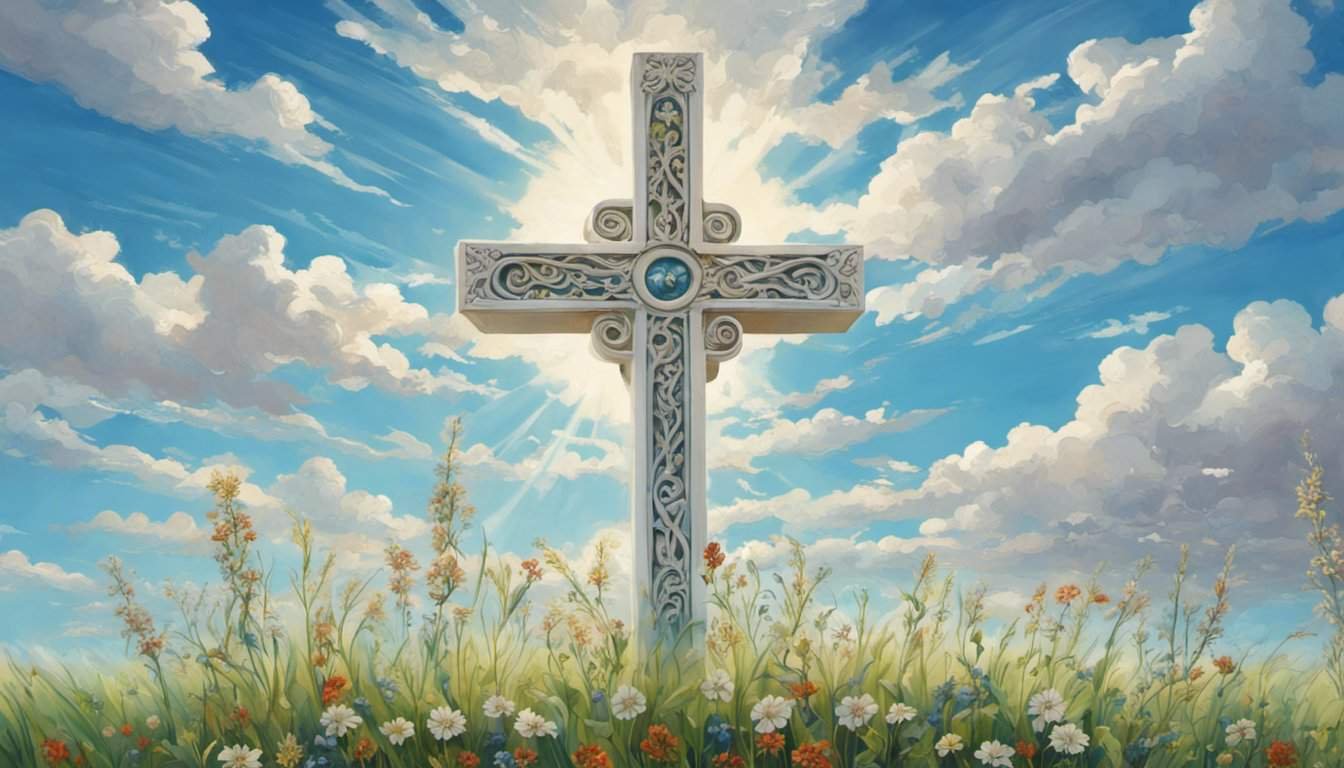Christian art appreciation invites believers to recognize and embrace the beauty found in creation. Through art, people can capture the divine essence that reflects God’s love and grace. Seeing beauty in creation allows individuals to deepen their spiritual understanding and connect with the core values of Christianity.
Engaging with Christian art opens a path to explore themes of redemption and hope, enriching one’s faith journey.


Art serves not only as a form of expression but also as a vital part of Christian life and worship. By looking at masterpieces and symbols, viewers gain insight into spiritual truths and the history of their faith.

Such experiences encourage personal engagement with both the artwork and the message it conveys, fostering a sense of community and shared belief among viewers.
In an ever-changing world, appreciating Christian art helps individuals find meaning in their lives and the world around them. It emphasizes the importance of beauty in understanding God’s creation, leading to a more profound relationship with faith and the teachings of Christianity.
Key Takeaways
- Christian art reflects core values and beliefs that enhance spiritual understanding.
- Engaging with art allows for personal connections to themes of redemption and hope.
- Appreciating creation through art fosters community and shared faith experiences.
The Essence of Beauty in Christian Art
Christian art serves as a reflection of deeper truths found in creation. It invites viewers to see beauty intertwined with goodness and truth. This section explores how beauty is understood in Christianity, as well as the specific concepts that shape Christian views on art.
Understanding Beauty
Beauty in Christian art is not just about aesthetics; it embodies deeper meanings. It reflects the Creator’s nature and invites a connection to faith.
Christian artists often strive to showcase beauty as a pathway to understanding truth and goodness.
Art pieces may depict Biblical scenes, saints, or nature, conveying spiritual insights. For instance, the use of light can symbolize divine presence, while vibrant colors evoke joy. This approach helps audiences recognize beauty as a glimpse of God’s creation and intention.
Christian Conceptions of Beauty
In Christianity, beauty is often linked with truth and goodness. It is seen as an expression of God’s character. Beauty reflects not only the visible world but also divine values.
Christian art aims to encourage believers, fostering a deeper faith experience. Artists like Michelangelo or Rembrandt showcase beauty by infusing emotional depth into their works. They not only capture moments but also convey messages of hope and redemption.
Through this lens, viewers are invited to ponder life’s meaning. In this way, beauty becomes a tool for spiritual exploration and the appreciation of God’s creation.
The Role of Art in Christian Life


Art plays an important role in the lives of many Christians. It serves as a way to express faith, worship God, and share the message of love and hope.
Through various forms, art connects believers to their faith and encourages a deeper appreciation of beauty in creation.
Art as a Form of Worship
Many Christians view art as a vital part of their worship experience. It can take many forms, such as painting, music, or dance. Each medium invites believers to engage their hearts and minds in a meaningful way.
For instance, church murals can inspire reflection, while music can uplift spirits during services. Art allows congregations to express their devotion and love for God in a creative manner.
As worshipers experience beauty, they often feel a deeper connection to their faith. This connection can remind them of God’s presence in their lives.
Art and Evangelism
Art also plays a crucial role in evangelism. It is a powerful tool for sharing the message of faith with others.
Creative works, from visual art to performance, can draw people in and make spiritual themes relatable.
For example, artwork depicting biblical stories can capture attention and invite conversation about faith. Music with meaningful lyrics can resonate with those searching for hope or truth.
By using art as a form of outreach, Christians can engage those who might otherwise be distant from the church. It helps convey complex ideas in accessible ways, opening hearts to the gospel.
The Expression of Faith through Art

Art provides a unique way for individuals to express their personal faith journeys. Christian artists often create works that reflect their experiences with God, love, and life.
This expression not only enriches their own faith but also encourages others to explore their beliefs.
Through art, Christians can share their struggles, joys, and discoveries. Whether through poetry, painting, or sculpture, these creative expressions can inspire others to look for beauty in their own lives.
Art invites people to engage in dialogue about faith, encouraging a deeper understanding of God’s love and grace. It fosters community among believers and can even bridge gaps with those outside the faith.
Exploring Christian Imagery and Symbols

Christian art is filled with rich imagery and deep symbolism. It reflects key beliefs and values through various visual elements. Understanding these aspects can enhance appreciation and insight into the faith.
Iconography in Christian Art
Iconography plays a crucial role in Christian art. It involves specific symbols that convey deeper meanings. For instance, the cross symbolizes Christ’s sacrifice, while the dove represents the Holy Spirit.
Many artists use saints as symbols of faith. Each saint is often depicted with unique attributes. For example, Saint Peter is shown with keys, symbolizing his role in heaven. These icons help believers connect with their faith visually.
Moreover, colors have significance too. The color gold often represents divine light, while blue signifies the heavens. Artists carefully choose these elements to evoke emotions and spiritual understanding in viewers.
The Use of Nature and Creation
Nature is a profound source of inspiration in Christian art. Many artworks depict scenes from the Garden of Eden or landscapes that reflect God’s creation. These images remind believers of the beauty and wonder of the world around them.

Artists often include animals or plants to symbolize specific concepts. The lamb signifies innocence and Christ’s role as the sacrificial lamb. Flowers like the lily often represent purity and the Virgin Mary.
The natural world in art can also inspire reflection on creation. By appreciating nature, believers can feel a deeper connection to their faith. This connection encourages awe and gratitude for the world God has made.
Through imagery and symbols, Christian art invites viewers to explore their beliefs in meaningful ways.
Great Works and Masters of Christian Art

Christian art has a rich history filled with masterpieces that reflect deep spiritual truths and beauty. This section explores crucial periods and artists that shaped how believers understand art in relation to faith.
Renaissance Influences

The Renaissance marked a significant shift in art, emphasizing humanism and the beauty of creation. Artists began to focus on naturalism and perspective.
Famous figures like Leonardo da Vinci and Sandro Botticelli advanced techniques to depict religious themes with emotional depth. Works such as The Birth of Venus and The Last Supper highlighted the connection between divine and human experiences.
Renaissance paintings often used symbolism to convey deeper religious meanings. This period encouraged artists to express their faith through various mediums, blending spirituality with expressive forms. Its impact led to a flourishing of art that continues to inspire today.
Michelangelo and the Sistine Chapel
Michelangelo is a towering figure in Christian art, known for his remarkable skill and passion. His work on the Sistine Chapel in Vatican City is a monumental achievement in art history.
The ceiling features scenes from Genesis, including the famous Creation of Adam, showcasing God’s relationship with humanity. Each figure is sculpted with such detail, capturing the emotion and grandeur of biblical stories.

Another notable work by Michelangelo is the statue of David. It represents the ideal of human beauty and spiritual strength. Both the Sistine Chapel and David demonstrate Michelangelo’s mastery, making him a pivotal figure in Christian art.
Contemporary Christian Art
Contemporary Christian art encompasses a variety of styles and mediums. Artists today explore faith through paintings, sculpture, and digital media, often blending traditional themes with modern influences.
Many contemporary works address current issues in society and spirituality. Artists like Makoto Fujimura use innovative techniques to create pieces that evoke a sense of beauty and contemplation.
This modern art movement invites viewers to engage with their faith in new ways. It shows that Christian art is still alive, reflecting both timeless truths and contemporary experiences.
Artistic Elements and Composition


Artistic elements and composition play a vital role in how viewers perceive beauty in Christian art. These aspects guide artists in creating works that resonate with the viewer’s emotions and faith. Understanding these components helps appreciate the effort behind each piece.
Understanding Visual Language
Visual language is how artists communicate ideas through imagery. Key elements of this language include color, line, shape, and texture. Each component can set a tone and evoke feelings.
For instance, warm colors like red and gold often symbolize love and divinity, while cool colors like blue and green can convey peace and tranquility.
Lines can direct the viewer’s eye, leading them through the artwork. A clear composition ensures that these elements work together harmoniously. It enhances clarity, allowing the message to resonate with viewers.
By studying these aspects, one can deepen their appreciation for the way Christian art conveys spiritual truths and emotions.
The Balance of Unity and Proportion

Unity and proportion are essential for effective composition in art. Unity refers to how different elements come together to create a cohesive work. It helps the viewer feel connected to the artwork and its message.
Proportion deals with the size relationships between elements within the piece. Artists often use techniques like the golden ratio to create balance. This can make certain elements stand out or feel harmonious within the artwork.
In Christian art, achieving unity can enhance the portrayal of spiritual themes. For example, figures may be proportionally larger to signify their importance.
Spirituality and Artistic Creation
Art and spirituality share a unique bond that enhances the creative process. For many artists, their faith and techniques come together to express deeper meanings. This connection helps artists portray their beliefs and experiences through their work, weaving together creativity and spirituality.
The Interplay of Spirituality and Technique

Artists often blend their spiritual beliefs with their artistic techniques. This fusion allows them to express complex emotions and ideas tied to their faith.
For example, an artist might use specific colors or styles to symbolize various aspects of their spirituality. Bright colors may represent joy and hope, while darker shades can evoke struggle or doubt.
Artists also develop techniques that reflect their beliefs. They might spend time in prayer or meditation before creating, seeking inspiration from their faith. This process not only aids creativity but also ensures that their work resonates with viewers on a spiritual level.
Art as a Reflection of the Divine
Art serves as a powerful medium for expressing the goodness of God. Many artists find that their creations reflect divine beauty and truth.
When they depict landscapes, people, or abstract forms, they are often inspired by their experiences of the divine. For them, creating art is an act of worship. It allows them to share their spiritual insights and invite others to see the world through their eyes.
This reflection of the divine encourages viewers to appreciate the beauty in creation. It fosters a deeper understanding of faith, revealing the connection between artistry and spirituality. Through their work, artists guide others to recognize God’s presence in daily life.
Cultural Impact of Christian Art
Christian art has played a significant role throughout history, shaping culture and influencing perspectives on beauty and spirituality. This type of art not only reflects religious beliefs but also impacts modern culture in unique ways.
Christian Art through the Ages
From early church mosaics to Renaissance paintings, Christian art has enriched culture for centuries. Artists like Michelangelo and Leonardo da Vinci transformed religious themes into breathtaking works. They helped people see stories from the Bible in fresh and moving ways.
These masterpieces inspired viewers and deepened their faith. For example, the Sistine Chapel’s ceiling offers a visual journey through creation, which influences how believers perceive their relationship with God. Additionally, Christian art helped define cultural moments, bringing communities together through shared beliefs and aesthetics.
The Influence on Modern Culture
In the modern world, Christian art continues to impact various aspects of culture. It shapes music, literature, and even film.
Many contemporary artists incorporate Christian themes into their work, exploring complex questions of faith and existence.
For instance, modern Christian music often blends styles, reaching a wider audience. Artists use lyrics to express their beliefs, creating a sense of community among listeners. Visual artists also challenge norms by infusing traditional techniques with modern ideas, promoting dialogues about faith in new ways.
This blending of the old and new showcases the enduring relevance of Christian art, reminding society of its roots while encouraging fresh perspectives. It fosters understanding and appreciation for the rich cultural heritage that continues to inspire today.
Personal Engagement with Christian Art

Engaging with Christian art is a deeply personal experience. It invites individuals to explore their feelings, connect with their faith, and foster joy through creativity. The appreciation of art speaks to the heart and soul, often igniting the imagination.
Art Appreciation as Personal Experience
For many, appreciating Christian art goes beyond mere observation. It becomes an intimate experience that resonates with their beliefs and emotions. Each piece of art carries a story, allowing viewers to connect with spiritual themes.
Art offers a chance to reflect on one’s faith and find joy in beauty. The vibrant colors and intricate details often evoke feelings of peace and gratitude. By engaging with each piece, individuals allow themselves to be transported into a deeper spiritual realm.
The Role of the Heart and Imagination
The heart plays a crucial role in how individuals experience art. It allows them to feel the emotions and messages behind each creation. Imagination fuels curiosity and invites exploration of the meanings held within the artwork.
Through imagination, viewers can picture themselves in biblical scenes or connect with the divine. This connection often brings joy and fulfillment. By engaging their hearts and imaginations, they experience a richer, more meaningful appreciation of the art around them.
Christian Art in Literature and Media
Christian art is present in various forms of literature and media. It helps people connect with spiritual truths and experience beauty through stories, poetry, and music. These expressions often reflect themes of faith, love, and divine beauty.
Depictions in Books and Poetry
Books and poetry often explore Christian themes using rich metaphors. Classic authors like John Milton in “Paradise Lost” delve into biblical stories, portraying the beauty and tragedy of the human condition. His use of vivid imagery allows readers to feel the weight of sin and the promise of redemption.
Modern Christian literature also captures these themes. Writers like C.S. Lewis blend fantasy with profound truths in works such as “The Chronicles of Narnia.” These stories invite readers to see parallels between everyday life and spiritual realities.
Poetry, too, serves as a powerful medium. Poets like George Herbert use striking imagery to convey their faith, creating a sense of intimacy with God. In each line, they invite readers to reflect on the beauty of creation and its connection to the divine.
Visual and Musical Expressions
Visual art plays a significant role in expressing Christian ideas through various media. Artists like Michelangelo created masterpieces that depict biblical scenes, urging viewers to appreciate the glory of God. Their works encourage contemplation and inspire awe in the viewer.
Music also expresses Christian beliefs beautifully. Hymns and contemporary Christian songs convey powerful messages through lyrical storytelling. Instruments like the piano or guitar enhance these messages, creating emotional connections with listeners.
For example, songs by artists such as Chris Tomlin often blend scripture with melody, making faith accessible and relatable. Through both visual and musical art, people can experience beauty and draw closer to their faith.
Educating and Experiencing Art
Understanding Christian art involves both education and hands-on experiences that deepen appreciation. Learning through literature and visiting museums can open up new perspectives and insights into the beauty of creation.
Learning through Christian Art Literature
Reading literature on Christian art enriches the mind and spirit. Authors like C.S. Lewis have explored how beauty relates to faith. His works often highlight the connection between artistic expression and God’s nature.
Books about art history reveal how different movements reflect Christian values. They show how artists convey truths about beauty, goodness, and truth. Readers can gain insight into various styles and mediums, from illuminated manuscripts to contemporary pieces.
Incorporating educational resources such as articles, lectures, and workshops can enhance understanding. These materials encourage deeper discussions about the purpose of art in the Christian context.
Experiencing Art in Museums
Visiting art museums allows individuals to experience beauty in a personal way. Museums often curate collections that highlight Christian themes and artists. This exposes visitors to a variety of works, from classical to modern.
Guided tours can provide valuable context about the pieces. They can explain the artists’ intentions and historical backgrounds, creating a richer experience. Engaging with art through discussions can foster a sense of community.
Visitors might also find events such as art workshops or lectures. These interactive experiences help to connect participants with the artwork and the messages it conveys. By getting involved, individuals can appreciate the beauty of creation in a new light.
Themes of Redemption and Hope in Art

Art often reflects themes of redemption and hope, capturing the essence of the human experience. Through creative expressions, artists convey powerful messages related to the Gospel narrative and emphasize important symbols of sacrifice and renewal.
Art and the Gospel Narrative
Many artists draw inspiration from the Gospel narrative. The stories of Jesus’s life, death, and resurrection serve as a foundation for themes of hope and redemption.
For instance, paintings depicting the Last Supper illustrate the moment of sacrifice and the promise of new life. Such works remind viewers of the transformative power of grace and forgiveness.
Artists use rich colors and detailed imagery to express divine love and hope for a renewed existence. This connection to the Gospel encourages reflection on personal faith and the idea of a new heaven and new earth.
Imagery of Sacrifice and Renewal
Imagery of sacrifice and renewal is prevalent in many art forms. Artists often portray scenes of Jesus on the cross, symbolizing deep sacrifice.
These representations invite viewers to contemplate their own struggles and the hope found in faith.
Through powerful visuals, artists convey that even in suffering, there is a path to healing and renewal.
For example, the resurrection is frequently depicted, celebrating the promise of new beginnings.
This imagery reinforces the belief that through trials, one can find redemption, making the theme of hope an essential aspect of Christian art.












